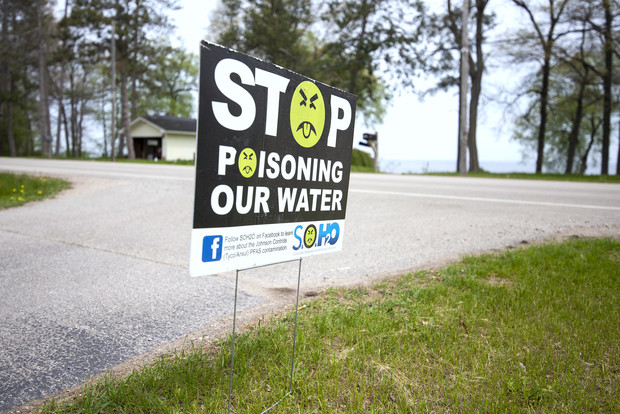DNR Wants Water Utilities Notifying Customers of PFAS
DNR urges notice after EPA releases much stronger PFAS standards.
As Wisconsin’s PFAS standards for drinking water take effect, state regulators are requiring water systems to notify customers about any detections of the so-called forever chemicals.
In February, the Natural Resources Board signed off on a drinking water standard of 70 parts per trillion for two of the most common PFAS chemicals: PFOA and PFOS. Republican lawmakers didn’t object to new regulation, and it took effect on Aug. 1.
“We’re recommending that they share that information with their consumers in a timely matter,” said Steve Elmore, director of the DNR’s Drinking Water and Groundwater Bureau. “It is a requirement that they include any detects of those substances in their Consumer Confidence Report, which is an annual publication that highlights the water quality of the system.”
PFAS, or perfluoroalkyl and polyfluoroalkyl substances, are a class of thousands of synthetic chemicals found in firefighting foam and everyday products. Research has shown they’re linked to serious health effects that include increased risk of kidney and testicular cancers, thyroid disease and fertility issues. The chemicals have also been tied to reduced response to vaccines.
While regulators urge systems to notify customers, Elmore noted one complicating factor is that most labs can’t detect the chemicals at the EPA’s advisory limits. The state’s current methods for measuring PFAS can only identify the chemicals down to about 1 part per trillion.
“It’s hard to tell my members to tell a customer your water is good, or your water still has some of this stuff in it, but we just don’t know how much,” said Groh. “That doesn’t help. That doesn’t let the customer know that they have for sure good water.”
Even so, state and federal regulators stress that lowering levels of the chemicals limits exposure even if PFAS can’t be detected at the EPA’s interim limits.
“If you do find it, finding ways to lower the levels, like turning off wells or adding treatment to the wells that are affected, can lower the risk,” said Elmore.
In the state’s largest city, Milwaukee Water Works has been including test results for PFAS in its water quality reports every year since 2016. The most recent report found PFAS levels in Milwaukee’s drinking water below 3 parts per trillion, according to results from a Eurofins lab in Indiana.
“We’ll have to make that clear in our water quality report — the limitations of the technology. But the bottom line is that people need to know, people deserve to know what’s in their water,” said Brian Rothgery, spokesperson for Milwaukee Water Works. “And so we will communicate to our consumers whatever the levels are that we detect.”
So far the DNR has collected around 300 samples from 129 systems. Of those, PFAS was detected in 38 public water supplies.The chemicals have been found in drinking water for Milwaukee, Madison, La Crosse, Eau Claire and Wausau.
In February, Wausau notified residents of elevated levels of PFAS in all six city wells. The city has set a goal to lower PFAS levels below 20 parts per trillion — the groundwater standard recommended by the Wisconsin Department of Health Services.
In June, the city approved a plan to spend $16.8 million to reduce PFAS in its drinking water by installing carbon filters, known as granular activated carbon, at a new treatment plant that’s currently being built. The city would borrow money in the short-term and seek reimbursement from state programs.
“When you’re talking about parts per quadrillion, I understand there’s probably a lot of science that goes into making sure you’re identifying correctly,” said Rosenberg. “But for now, it’s the same situation that we’ve been dealing with since February.”
Elmore said available treatments like granular activated carbon have been shown to remove PFAS to non-detectable levels.
In the meantime, the DNR is requiring systems to take additional steps to limit exposure if levels of the chemicals are found at 70 parts per trillion or higher as the agency begins monitoring them for compliance in November. The EPA continues to develop national standards for the chemicals in drinking water, and the DNR expects federal regulators will release a draft proposal this fall.
Listen to the WPR report here.
DNR urges water systems to notify customers of any PFAS detected in drinking water was originally published by Wisconsin Public Radio.
More about the PFAS Problem
- EPA Slaps Two PFAS Chemicals With Superfund Law Designation - Danielle Kaeding - Apr 19th, 2024
- DNR Responds To EPA’s Designation Of PFOA And PFOS As Hazardous Substances - Wisconsin Department of Natural Resources - Apr 19th, 2024
- Evers Won’t Rule Out Court Challenge to Force Release of PFAS Funds - Danielle Kaeding - Apr 16th, 2024
- Gov. Evers Vetoes PFAS Bill, Calls Special Meeting of Budget Committee - Baylor Spears - Apr 10th, 2024
- DNR, DHS Respond To EPA’s Announcement Of Maximum Contaminant Levels For PFAS In Drinking Water - Wisconsin Department of Natural Resources - Apr 10th, 2024
- GOP Leaders Urge Gov. Evers to Sign Divisive PFAS Bill - Baylor Spears - Apr 2nd, 2024
- UW-Madison to Open PFAS Center - Robert D'Andrea - Apr 1st, 2024
- Gov. Evers Slams Republicans for Continued Delays Releasing Critical Funds to Fight PFAS Statewide, Stabilize Healthcare Industry in Western Wisconsin - Gov. Tony Evers - Mar 11th, 2024
- Wisconsin DNR Update On WMC And Leather Rich, Inc V. DNR - Wisconsin Department of Natural Resources - Mar 8th, 2024
- State Appeals Court Blocks DNR’s Regulation of PFAS - Danielle Kaeding - Mar 6th, 2024
Read more about PFAS Problem here

















